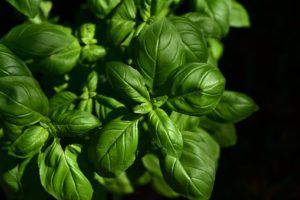
Basil ( ocimum basilicum) is a plant some of us cannot do without.
Growing Hydroponic Basil means that you get a faster growing, more flavoursome, healthier plant.
Herbs grown hydroponically, cut and added to your cooking will enhance your dishes in a way not experienced before.
Basics
So growing basil in a hydroponics system.
- What do you use
- How do you feed it
- How much light does it need
- Is there anything else I need to know.
Let’s look at these in turn
Systems – what do you use
What’s the best system to grow basil in.
Basil can get quite tall if you let it grow straight up.
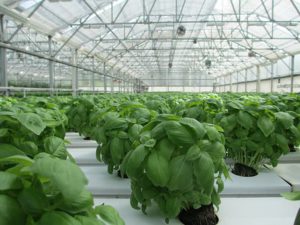
So you need a system which can support upper growth in a mild breeze.
Any of the systems which have a pot and substrate will be able to grow basil. DWC, ebb and flow, aeroponics, and NFT.
Nutrients
To grow basil well you need a nutrient rich in nitrogen, with the main part of basil being the leaves.
Canna vega, designed for vegetation is highly suitable.
As basil takes up potassium and calcium at a high rate you will need to replace the nutrient mix slightly more often than a lot of other leafy veg. This way you will keep the flavour and essesntial oils in the leaves for you to enjoy.
If you are using a pH and EC meter, you need to keep the pH between 5.5 and 6.5, with the EC between 1.6 and 2.2.
From seedling, which you just add water until the plants have two main leaves, you start to add nutrient at half strength until the plant is used to it and gradually increase the strength over the next few days.
Lighting
Basil responds well to good levels of lighting.
You may need to add lighting to get the optimum yield from your hydroponic basil but it will grow under most lighting.
It ideally need between 12-14 hours a day of light.
If you can measure the level of lighting then go for above 12mol/m2.
Other requirements
Basil grows well with lots of carbon dioxide, or lots of airflow.
It doesn’t like it windy, but changes of air are good. Basil is a delicate plant.
So it maybe worth setting up a low speed fan to move the air about your system to allow optimum growth.
Optimum growing temperature is 65 – 75F ( 18- 24C)
If you can keep the humidity above 50% your basil will thank you for it.
To increase the humidity locally, you can add a tray of water with clay ball in. This will evaporate slowly raising the humidity locally.
Or mist the leaves daily with water.
Growing
Easy to grow – ideal for children learning about hydroponics
Propagating
Basil is very easy to grow.
Place your seeds deep enough to prevent drying out and this will help the seed coat release as it grows.
Place a couple of seeds in a grow block at a depth of 5-10mm
Place in a propagator or plastic bag to keep the humidity high and temperature between 60 – 77F (15-25C).
You should see the seeds emerge after 7 days.
Use straight water for a few days and then swap over to a half strength nutrient mix for a week, before going up to full strength.
If there is too much water your seedlings may wilt with their stems shrinking close to where they exit the substrate, you have a disease called damping off.
This is caused by fungi.
The main thing to do in cases like this is to thoroughly clean the equipment before using again and don’t overwater.
High humidity and high temperature will cause the fungi to grow.
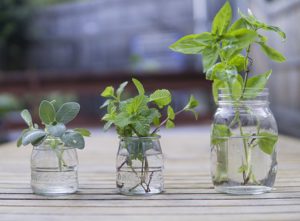
You can also use the cuttings you take from your plant to create more plants.
After taking the cutting, strip any lower leaves and place the cutting in a glass of water, replace the water every few days and after a week start to add nutrient at half strength.
You should see roots start to emerge and your new plant can be placed into your hydroponic system.
Growing
Growing on from transplanting into your hydroponics system, the main thing you need to do with basil is to replace the nutrient solution more frequently.
This is due to the uptake of calcium and phosphorus.
Reducing these levels will reduce the flavour of the leaves.
Check the plant daily for any signs of bugs or diseases.
Watch it grow into a healthy plant, to enjoy in your cooking.
Care
Basil does not like drafts – so be warned.
If it is in a draft then expect to be adding a lot more water as it will try to dry out.
Harvesting
As you basil plant grows you can increase the ‘bushiness’ of it by trimming the main growth and leaving the two lateral leaf nodes.
These will form two stems from that point creating a bushy plant.
Again once these two stems have created a main leaf and started on another stem, cut it back to the two leaf nodes to create more stems.
This way you will have a bushy herb rather than a tall and leggy one hogging all of the light.
You can harvest the basil plants as microgreens.
Once they have grown two to four leaves the plant will have all of the basil flavour, but a milder version.
There is a lot of talk about basil being a plant you grow yearly, but inside when the temperature does not drop too low then you can keep it going.
As long as you pinch out the flowering parts when they start to grow you can keep it going for a long time.
Mine managed to survive for 5 years, until it had an attack of aphids which i didn’t clear quickly enough.
If you let it flower the flavour of the leaves will change to a more bitter flavour, but it is still usable in cooking but limited in salads
Pests
Aphids, whiteflies and sometimes thrips can all attack your basil plant.
Having a good airflow will go someway to preventing these pests.
If you have an outbreak then a spray of neem oil will reduce the outbreak, but keep a close eye on your plants for a reoccurrence.
Diseases
Fusarium wilt and downey mildew can affect you basil plants.
If you see a whitish coating on your leaves it maybe a sign that you have mildew, normally caused by having the humidity too high and lack of airflow.
It is a fine balance between keeping the humidity high enough for this plant and having enough airflow to prevent diseases.
If your plant seems to wilt in the sunlight but recovers in twilight then you may have fusarium wilt.
This is a fungus attacking the roots of your plant, preventing the uptake of water and nutrients.
It is normally in soil based systems, so mainly if you are growing basil in your garden, but can attack hydroponic systems.
Replace the nutrient and see if that helps, but you may need to harvest the plant and thoroughly clean the system before replanting.
Pythium – root rot can affect it.
If you notice the roots going brown, rather than being white then change your nutrient and maybe just add water for a few days.
Varieties
There are up to 150 different varieties of basil, according to Wiki, but not all are related to what we know as basil.
The main ones are listed below with their optimum growing times.
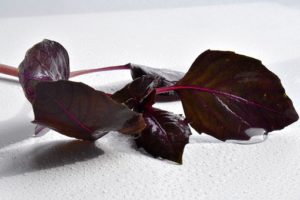
genovese basil – classic pesto flavour heavy cupped leaves culinary use. also known as sweet basil. 68 days
Purple/red basil -same as genovese but different colour. 68 days
Citrus- essence of lemon or lime , dependant on variety. 60 days
Greek – small miniature leaves greek flavour. 40 -45 days
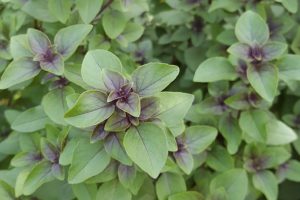
Asian/thai – also known as tulsi or holy basil, with its liquorice flavour. 64 days
Lettuce leaf basil – leaf 5 in long milder flavour than genovese. 78 days
Uses
Basil has a number of uses, the main one people know is cooking.
Add at the very end of cooking as it is a sensistve herb to heat and cold.
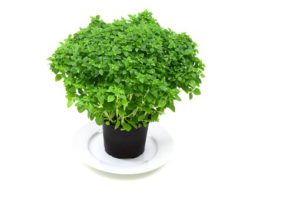
But it is also a useful herb to eat if you suffer from constipation, stomach problems or flatulence.
If you want to freeze the leaves then coat them in olive oil first.
Or you could add them to oil or vinegar and leave them on the window sill to infuse.
if you want to dry the leaves try adding salt to help them dry out.
With their antibacterial properties you can add them to vegetable water to help clean the skin of the veg you are washing.
Tips
Don’t store cut leaves in the fridge – will go black
Use glass of water and put stem in water – will last a long time.
Cut the stems with sharp shears, they are tougher than you think.
Grow this herb with chives to reduce the risk of infestation with aphids.
In conclusion
So you now have a lot of information about how to grow basil hydroponically.
You can grow it very successfully within an aerogarden unit.
Make sure you plant it at the back as it is a tall plant which grows quickly.
But once growing you can keep it alive for years.
As I said I had a plant growing for five years, which I thought was pretty good.
We did use it cooking and froze quite a bit, gave some away to friends.
But it was all enjoyed.
So it is a plant I would recommend growing hydroponically.
So rather than going to the grocery store for some why not grow your own.
With its fresh taste and top quality leaves you cannot go wrong with this herb.
Leave a comment on your experiences on growing hydroponic Basil.
Many thanks for reading
Phil

Fantastic article my wife and I were talking about growing our own herbs and basil being top cause she uses it a lot. Your guide to growing it looks like we would have no problem.
Thank you for this great read and right on time I must say.
I will be forwarding this to my wife.
David
Thank you David, for taking the time to read the article.
As you say basil is used a lot in cooking and so easy to grow.
Don’t forget to freeze your excess rather than dry it – as drying it loses that wonderful flavour.
It is worth trying in an aerogarden for convenience on the kitchen countertop.
This makes it available anytime you are cooking.
Good luck with growing it.
Phil
Hello Phil,
Thanks for this informative post, now I know how to grow this kind of herb (Basil).
I am going to follow all your guides and even share it with my friends who are growing herbs.
I agree with you that we must grow plants by ourselves rather than buying on grocery stores which are coated with pesticides and it could be bad for our health.
Regards,
Yuji
I am glad you found this infomative Yuji.
You will be amazed at the difference in flavour from growing your own herbs rather than buying them.
As you say you never know what has been used in the growing process, at least with growing them at home you know.
I hope you do start to grow your own soon.
Phil